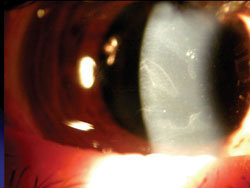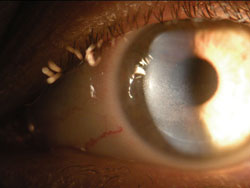Optimal vision requires healthy ocular surface in cataract, refractive patients
Visual results of surgery often depend on a good tear film.
You have calculated the best lens implant power and performed a meticulous cataract surgery, but your patient is still not seeing well.
 Uday Devgan |
We often forget that the first refracting component of the eye is the air-fluid interface of the tear film and that optimal vision requires a healthy ocular surface.
Etiology
A thorough preoperative examination can pick up subtle signs of ocular surface disease and tear film dysfunction. The most common abnormality seen before surgery is dry eye syndrome, particularly in the older cataract population.
A rapid tear breakup time or a poor tear lake would warrant further testing with dye staining of the ocular surface. Vital dyes such as lissamine green are particularly effective in the diagnosis and evaluation of dry eye syndrome. Staining of the bulbar conjunctiva, as well as the cornea, is frequently done in these patients. Fluorescein dye will stain areas of epithelial loss such as superficial punctate keratopathy, and the absence of fluorescein in an area may suggest epithelial basement membrane dystrophy (EBMD).
EBMD is also referred to as map-dot-fingerprint dystrophy because of the irregular appearance of the epithelium when examined at the slit-lamp microscope. This irregular epithelium can cause the patient symptoms of irritation, as well as decreased visual quality and acuity (Figure 1). Treatment of EBMD, which is typically corneal scraping via mechanical instruments or excimer laser, should be performed before cataract surgery to optimize the surface and make preoperative keratometry more accurate.
 Figure 1. Epithelial basement membrane dystrophy (EBMD) is often referred to as map-dot-fingerprint dystrophy because of its characteristic appearance on microscopic examination. EBMD should be treated before cataract surgery to provide a better surface and more accurate keratometry. |
 Figure 2. This patient experienced severe dry eye and ocular surface epitheliopathy after LASIK. The edge of the LASIK flap is seen, as well as a band of corneal epithelial punctate keratopathy. The LASIK flap interrupted many of the corneal nerves involved in regulation of tear production. Images: Devgan U |
Optimizing the ocular surface before surgery is important to minimize the postop symptoms and maximize the postop vision. Remember that patients who are educated preoperatively about the possibility of dry eye syndrome are more receptive about treatment than patients who are surprised by postoperative ocular surface issues.
With any corneal incision, nerves are cut and the sensory loops that help to regulate tear production are interrupted. Although we now have smaller incisions for phacoemulsification, the addition of limbal relaxing incisions for the treatment of astigmatism causes more corneal nerves to be severed and may lead to worsening of dry eye syndrome. In cases in which a bioptics approach is used, with both IOL placement as well as excimer laser ablation, the patient is at an even higher risk of dry eye syndrome.
Certain aspects of dry eye syndrome are now understood to be inflammatory in nature. Cataract and refractive surgery, although minimally invasive and safe, induce postoperative inflammation that may worsen ocular surface dysfunction.
Treatment
The two primary classes of pharmacologic treatment of dry eye syndrome and ocular surface dysfunction are tear replacements and anti-inflammatory medications. Tear replacements help to replenish and protect the ocular surface, whereas the anti-inflammatory drugs help to control the inflammatory component of dry eye syndrome, as well as the iatrogenic postoperative inflammation.
There are many types of tear replacements available, but they all have common characteristics. There is a demulcent component that soothes and protects, a viscosity enhancer that allows the tears to stay in contact with the ocular surface longer, and osmolytes and electrolytes that balance the artificial tear with natural tears.
The demulcents commonly used are polyethylene glycol in Blink Tears (Abbott Medical Optics) and Systane Tears (Alcon Labs), and carboxymethylcellulose in Optive and Refresh Tears (Allergan). To thicken the tears, glycerin is added to Optive, hydroxypropyl guar is added to Systane and sodium hyaluronate is added to Blink Tears. Intraoperatively, hyaluronate is used as a key component of viscoelastics to protect the delicate corneal endothelium during cataract surgery.
In addition, surgeons often like to place hyaluronate on the corneal epithelium to prevent drying during phacoemulsification. Using hyaluronate as a component of artificial tears may be beneficial as a protectant in this regard.
Treatment of inflammation is important in addressing dry eye syndrome, and this can be accomplished with multiple classes of medications, such as corticosteroids, NSAIDs and other immune modulators such as cyclosporine A. The inflammation induced by surgery is typically treated in the postoperative period with corticosteroids and NSAIDs, and combining both products may have synergistic benefits.
Fortunately, most cases of postoperative dry eye syndrome and ocular surface dysfunction are temporary, and after appropriate treatment, these patients do very well. Sometimes an important part of the surgical planning is more than the surgery itself; it is the health and function of the rest of the visual pathway, including the ocular surface.

- Uday Devgan, MD, FACS, is in private practice in Los Angeles, chief of ophthalmology at Olive View-UCLA Medical Center and associate clinical professor at the UCLA School of Medicine. He can be reached at 11600 Wilshire Blvd., Suite 200, Los Angeles, CA 90025; 800-337-1969; e-mail: devgan@gmail.com; Web site: www.udaydevgan.com. Dr. Devgan is a consultant to Abbott Medical Optics and Allergan, and is a stockholder in Alcon Laboratories and formerly in Advanced Medical Optics and Allergan. He has no direct financial interest in the products mentioned.
